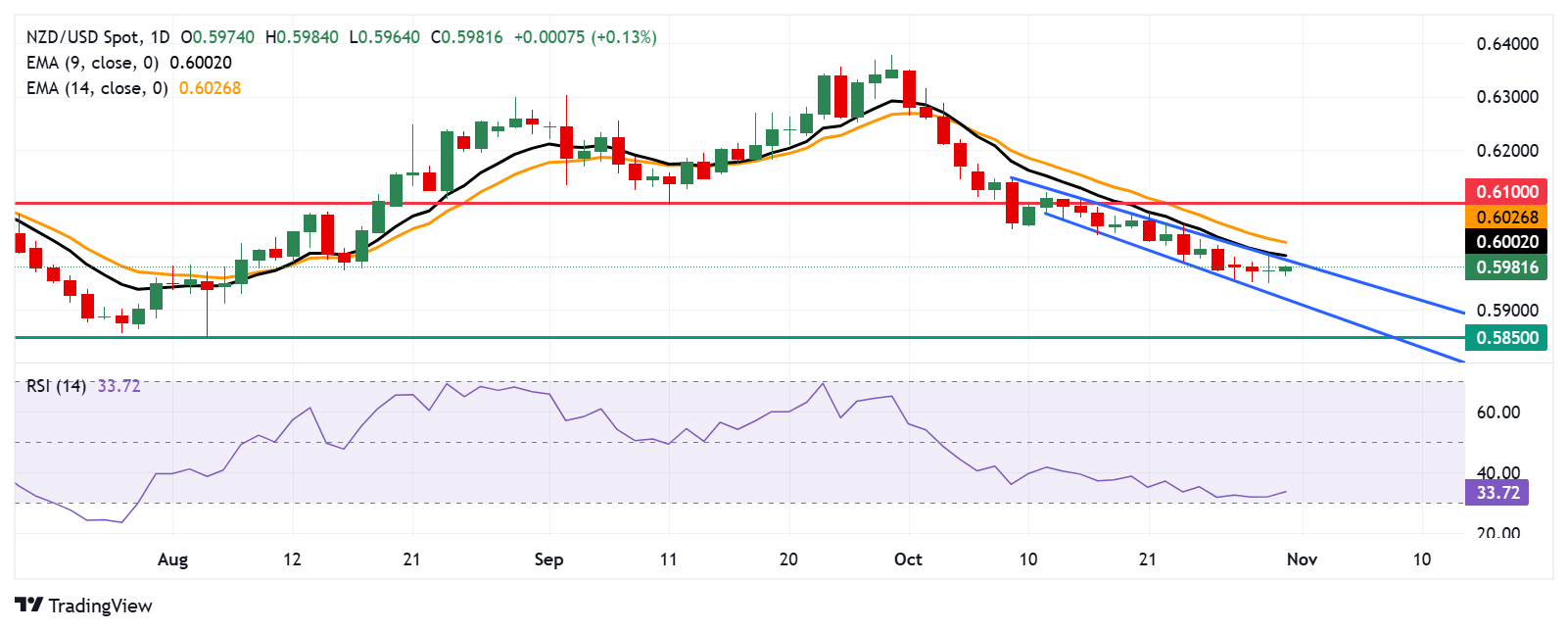- Analytics
- News and Tools
- Market News
- NZD/USD Price Forecast: Remains below 0.6000, upper boundary of the descending channel
NZD/USD Price Forecast: Remains below 0.6000, upper boundary of the descending channel
- NZD/USD may test the upper boundary of the descending channel pattern.
- A drop in the 14-day RSI below 30 mark would indicate an oversold condition, potentially suggesting an upcoming upward correction.
- The pair may aim for the lower boundary of the descending channel near the 0.5920 level.
The NZD/USD pair extends gains for the second consecutive session, trading near 0.5980 during Thursday's European session. Daily chart analysis shows a bearish bias, with the pair moving within a descending channel. A breakout above this descending channel could signal a potential shift in momentum.
Further supporting this outlook, the nine-day Exponential Moving Average (EMA) remains below the 14-day EMA, reinforcing the bearish sentiment for NZD/USD. Short-term momentum appears weak, indicating continued downward pressure.
The 14-day Relative Strength Index (RSI), a key momentum indicator, hovers just above 30. A dip below this threshold would signal an oversold condition, potentially hinting at an impending upward correction for the NZD/USD pair.
On the downside, NZD/USD may approach the lower boundary of the descending channel near 0.5920. A decisive break below this support could drive the pair toward the next "pullback support" around the 0.5850 level.
On the resistance side, the initial hurdle for NZD/USD lies at the upper boundary of the descending channel, aligning with the nine-day Exponential Moving Average (EMA) near 0.6001, followed by the 14-day EMA at 0.6026. A sustained move above these EMAs could shift the pair to a short-term bullish stance, potentially targeting the psychological level of 0.6100.
NZD/USD: Daily Chart
New Zealand Dollar FAQs
The New Zealand Dollar (NZD), also known as the Kiwi, is a well-known traded currency among investors. Its value is broadly determined by the health of the New Zealand economy and the country’s central bank policy. Still, there are some unique particularities that also can make NZD move. The performance of the Chinese economy tends to move the Kiwi because China is New Zealand’s biggest trading partner. Bad news for the Chinese economy likely means less New Zealand exports to the country, hitting the economy and thus its currency. Another factor moving NZD is dairy prices as the dairy industry is New Zealand’s main export. High dairy prices boost export income, contributing positively to the economy and thus to the NZD.
The Reserve Bank of New Zealand (RBNZ) aims to achieve and maintain an inflation rate between 1% and 3% over the medium term, with a focus to keep it near the 2% mid-point. To this end, the bank sets an appropriate level of interest rates. When inflation is too high, the RBNZ will increase interest rates to cool the economy, but the move will also make bond yields higher, increasing investors’ appeal to invest in the country and thus boosting NZD. On the contrary, lower interest rates tend to weaken NZD. The so-called rate differential, or how rates in New Zealand are or are expected to be compared to the ones set by the US Federal Reserve, can also play a key role in moving the NZD/USD pair.
Macroeconomic data releases in New Zealand are key to assess the state of the economy and can impact the New Zealand Dollar’s (NZD) valuation. A strong economy, based on high economic growth, low unemployment and high confidence is good for NZD. High economic growth attracts foreign investment and may encourage the Reserve Bank of New Zealand to increase interest rates, if this economic strength comes together with elevated inflation. Conversely, if economic data is weak, NZD is likely to depreciate.
The New Zealand Dollar (NZD) tends to strengthen during risk-on periods, or when investors perceive that broader market risks are low and are optimistic about growth. This tends to lead to a more favorable outlook for commodities and so-called ‘commodity currencies’ such as the Kiwi. Conversely, NZD tends to weaken at times of market turbulence or economic uncertainty as investors tend to sell higher-risk assets and flee to the more-stable safe havens.
© 2000-2025. All rights reserved.
This site is managed by Teletrade D.J. LLC 2351 LLC 2022 (Euro House, Richmond Hill Road, Kingstown, VC0100, St. Vincent and the Grenadines).
The information on this website is for informational purposes only and does not constitute any investment advice.
The company does not serve or provide services to customers who are residents of the US, Canada, Iran, The Democratic People's Republic of Korea, Yemen and FATF blacklisted countries.
Making transactions on financial markets with marginal financial instruments opens up wide possibilities and allows investors who are willing to take risks to earn high profits, carrying a potentially high risk of losses at the same time. Therefore you should responsibly approach the issue of choosing the appropriate investment strategy, taking the available resources into account, before starting trading.
Use of the information: full or partial use of materials from this website must always be referenced to TeleTrade as the source of information. Use of the materials on the Internet must be accompanied by a hyperlink to teletrade.org. Automatic import of materials and information from this website is prohibited.
Please contact our PR department if you have any questions or need assistance at pr@teletrade.global.
















